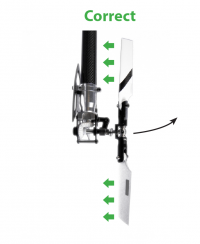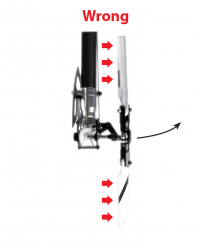Manuals:BXFbl:Setupmenu E/de: Difference between revisions
Shornstein (talk | contribs) Created page with "=Einstellung am Gerät= Mit der EasySetup-Einstellung am Gerät ist dieser Schritt in zwei Menüpunkte unterteilt. Im Menüpunkt '''E''' setzen wir die Heckrotorgrenzen, im Me..." |
Shornstein (talk | contribs) Created page with "==SETUP-MENÜ E - Heckrotorgrenzen== * Um die Servo-Limits einzustellen, bewege den Heckrotorhebel in eine Richtung, bis das Servo den maximalen Endpunkt erreicht, ohne dass e..." |
||
| Line 32: | Line 32: | ||
<br /> | <br /> | ||
==SETUP | ==SETUP-MENÜ E - Heckrotorgrenzen== | ||
* | * Um die Servo-Limits einzustellen, bewege den Heckrotorhebel in eine Richtung, bis das Servo den maximalen Endpunkt erreicht, ohne dass es klemmt oder blockiert. Lasse den Heckrotorhebel los, wenn die richtige Position erreicht ist. Wenn du das Servo zu weit bewegt hast, kannst du den Hebel in die entgegengesetzte Richtung steuern und den Pitch-Schieber ein Stück zurückbewegen. Du kannst den Hebel auch kurz antippen, um nur geringfügige Anpassungen vorzunehmen. Sobald der richtige Endpunkt gefunden wurde, bewege den Heckrotorhebel nicht mehr und warte eine Sekunde, bis die Status-LED blinkt. Dies zeigt an, dass die neue Position gespeichert wurde. (Falls nötig, kannst du die Position so oft ändern, wie du möchtest, aber warte immer, bis die Status-LED blinkt, bevor du fertig bist und zum nächsten Schritt übergehst!) | ||
* | * Nun stelle die entgegengesetzte Richtung ein. Verwende dafür erneut den Heckrotorhebel und halte ihn, um das Servo/den Heckpitch-Schieber in die andere Richtung zu bewegen. Gehe wie beschrieben vor, um den maximalen Endpunkt einzustellen, und warte erneut, bis die Position durch das Blinken der Status-LED angezeigt wurde. | ||
* | * Wenn beide Positionen eingestellt sind, gehe zum nächsten Menüpunkt '''F''', indem du kurz den Einstellknopf drückst.<br /> | ||
<br /> | <br /> | ||
Revision as of 14:23, 4 June 2024
Als nächstes müssen wir das Heckrotorgyro einstellen. Dazu setzen wir die Limits der Heckpitch-Steuerung und die Steuerungsrichtungen, damit der Kreisel das Servo nicht weiter bewegt als erlaubt und in die richtige Richtung.
In erster Linie sind die Limiteinstellungen notwendig, um zu verhindern, dass das Gyro das Servo über die mechanischen Grenzen hinaus bewegt und das Servo beschädigt. Beachte jedoch beim Einstellen der Grenzen, dass der optimale Ausschlag nicht unbedingt durch den maximal möglichen Steuerweg des Heckpitch-Schiebers bestimmt wird. Wenn die Heckmechanik einen sehr großen Pitch-Bereich zulässt, kann es ratsam sein, die Grenzen basierend auf dem maximal zulässigen Anstellwinkel der Heckrotorblätter einzustellen. Andernfalls kann ein hoher Heckpitch-Ausschlag einen aerodynamischen Strömungsabriss der Blätter verursachen. Solche Strömungsabrisse können ein sehr schlechtes Stoppverhalten verursachen, wie z.B. ein Überschießen des Hecks beim Stoppen der Rotation, und können auch eine schlechte Heckreaktion auf Heckrotorhebeleingaben bei Richtungsänderungen verursachen. Denke daran, dies bei der Einstellung der Endpunkte des Heckrotors zu berücksichtigen! Sieh im Handbuch des Hubschraubers nach, um herauszufinden, wie viel Heckpitch nützlich ist und wo die Endpunkte gesetzt werden sollen.
| Hinweis: Dieser Einrichtungsschritt gilt für BEASTX Geräte mit standardmäßiger Heckservosteuerung. Wenn du einen Hubschrauber mit Heckmotor verwendest, folge bitte der Beschreibung auf der nächsten Seite. Stelle sicher, dass du die richtige Firmware installiert hast, bei der die Funktion Heckmotor aktiviert oder deaktiviert ist. Wenn du die Heckmotor-Firmware verwendest, wirst du dein Heckservo nicht wie unten gezeigt korrekt steuern können und umgekehrt! |
Mechanische Einrichtung des Heckservos
Im folgenden Schritt dieser Einrichtung wirst du aufgefordert, das Heckservo an dein BEASTX Gerät anzuschließen. Beim MICROBEAST PLUS/ULTRA wird das Servo an den [CH4] Ausgang angeschlossen. Achte auf die korrekte Polarität, das schwarze oder braune Minus-Kabel muss am nächsten zur Unterseite des Geräts liegen. Beim NANOBEAST schließe das Servo bitte an den [CH2] Ausgang an. Hier ist die Servo-Polarität ähnlich wie bei SPEKTRUM/Horizon Hobby Servos, von innen nach außen: Signal, Minus, Plus.
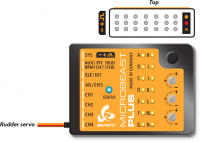
Befestige einen Servohorn am Heckservo so, dass die Heckanlenkungsstange einen 90-Grad-Winkel zum Servohorn bildet (oder so nah wie möglich) und passe die Anlenkungsstange wie im Handbuch deines Hubschraubers beschrieben an. Bei den meisten Hubschraubern sollte der Heckpitch-Schieber zentriert sein, und die Heckrotorblätter werden dann einen gewissen positiven Pitch haben, um das Drehmoment des Hauptrotors auszugleichen.

Diese mechanische Einstellung ist besonders wichtig, wenn das Heckgyro im Normal-Rate-Modus verwendet wird. Wenn die Einstellung nicht korrekt durchgeführt wurde, wird der Hubschrauber ständig auf der Heckrotorachse zu einer Seite driften. Wenn das Heckgyro nur im HeadingLock-Modus verwendet wird, ist diese Einstellung nicht so kritisch. Hier wird das Gyro den Heckrotor aktiv steuern, sodass der Hubschrauber den Befehlen des Heckrotorhebels genau folgt. Dennoch ist für die optimale Leistung des Gyros eine gute mechanische Einstellung unerlässlich!
Einstellung am Gerät
Mit der EasySetup-Einstellung am Gerät ist dieser Schritt in zwei Menüpunkte unterteilt. Im Menüpunkt E setzen wir die Heckrotorgrenzen, im Menüpunkt F lernen wir die Steuerungsrichtung ein.
SETUP-MENÜ E - Heckrotorgrenzen
- Um die Servo-Limits einzustellen, bewege den Heckrotorhebel in eine Richtung, bis das Servo den maximalen Endpunkt erreicht, ohne dass es klemmt oder blockiert. Lasse den Heckrotorhebel los, wenn die richtige Position erreicht ist. Wenn du das Servo zu weit bewegt hast, kannst du den Hebel in die entgegengesetzte Richtung steuern und den Pitch-Schieber ein Stück zurückbewegen. Du kannst den Hebel auch kurz antippen, um nur geringfügige Anpassungen vorzunehmen. Sobald der richtige Endpunkt gefunden wurde, bewege den Heckrotorhebel nicht mehr und warte eine Sekunde, bis die Status-LED blinkt. Dies zeigt an, dass die neue Position gespeichert wurde. (Falls nötig, kannst du die Position so oft ändern, wie du möchtest, aber warte immer, bis die Status-LED blinkt, bevor du fertig bist und zum nächsten Schritt übergehst!)
- Nun stelle die entgegengesetzte Richtung ein. Verwende dafür erneut den Heckrotorhebel und halte ihn, um das Servo/den Heckpitch-Schieber in die andere Richtung zu bewegen. Gehe wie beschrieben vor, um den maximalen Endpunkt einzustellen, und warte erneut, bis die Position durch das Blinken der Status-LED angezeigt wurde.
- Wenn beide Positionen eingestellt sind, gehe zum nächsten Menüpunkt F, indem du kurz den Einstellknopf drückst.
SETUP MENU F - Rudder control direction
- Move the rudder stick and check the rudder direction on the helicopter. If the stick is moving the servo into the wrong direction use the servo reverse function of your transmitter and reverse the rudder channel to set stick control direction correctly.
- Now set the rudder direction of the BEASTX system: When you move the rudder stick to the right, the Status LED must light up or flash in blue color. When you move the rudder stick to the left, the Status LED must light up or flash in red color. When the display is inverted (red = right and blue = left) reverse the display (internal control direction) by tapping the aileron(!) stick once.
- Optional: When you move the rudder stick to full deflection, the Status LED should light solid, not just flash. If this is not the case, increase the servo throw/endpoint of the rudder channel in the transmitter just as far so that the Status LED changes from flashing to solid when the rudder stick reaches the end position. (Note: Do not increase the endpoint too much in the transmitter. We need an exact match of full stick position and stick end position. So the Status LED should just change from flashing to solid when raching the end position.)
Always set servo directions in the transmitter first, then check the Status display of your BEASTX device or in the StudioX app. Change the internal control direction if it does not match the real direction. Do not change the internal direction in order to change the servo direction! This is only used for telling the gyro in which direction it must move the servo. Be very conscientious when doing this setup step, as wrong gyro direction will cause loss of control during takeoff and you probably crash the helicopter!
In addition you can check the gyro direction by turning the helicopter by hand around its vertical axis. When turning the heli the gyro must move the servo so that the rotor will produce a counter action agains the turn direction. So later in flight the gyro will stop the helicopter from unwanted movement. Here the LED will light up in blue color when you turn the helicopter to the right and light up in red when you turn it to the left. So you can get a little reminder when you do not know which is the correct stick direction to setup, when you need to do the setup later on the field!
Setup with StudioX app
- When you move the rudder stick to full deflection, the Status LED on the BEASTX system should light solid and the label right or left should change the color accordingly. If the stick is not moving far enough, you will see the message "Increase!" In this case increase the servo throw/endpoint of the rudder channel in the transmitter just as far so that the Status LED changes from flashing to solid when the rudder stick reaches the end position and the label will disappear in the software. Repeat this for the other direction. Note: Do not increase the endpoint too much in the transmitter. We need an exact match of full stick position and stick end position. So the Status LED should just change from flashing to solid when raching the end position.
<img class="ios" src="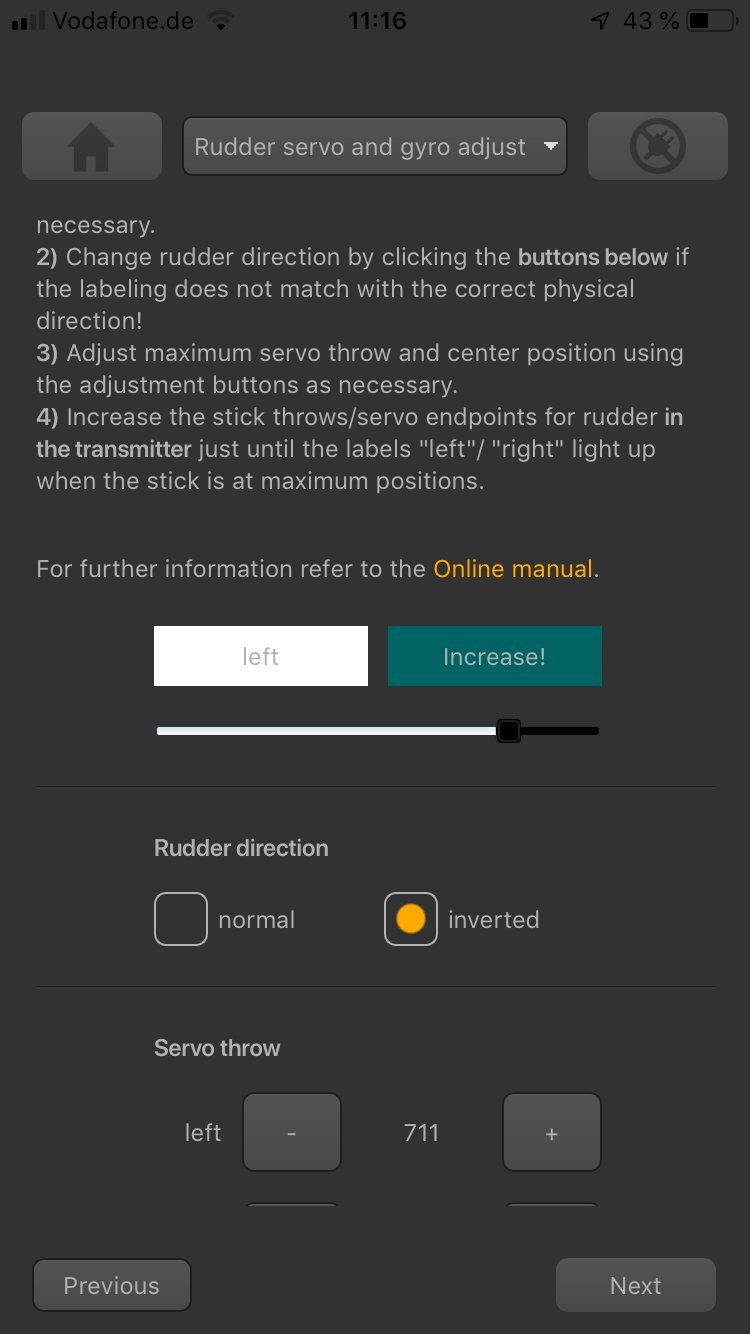
<img class="ios" src="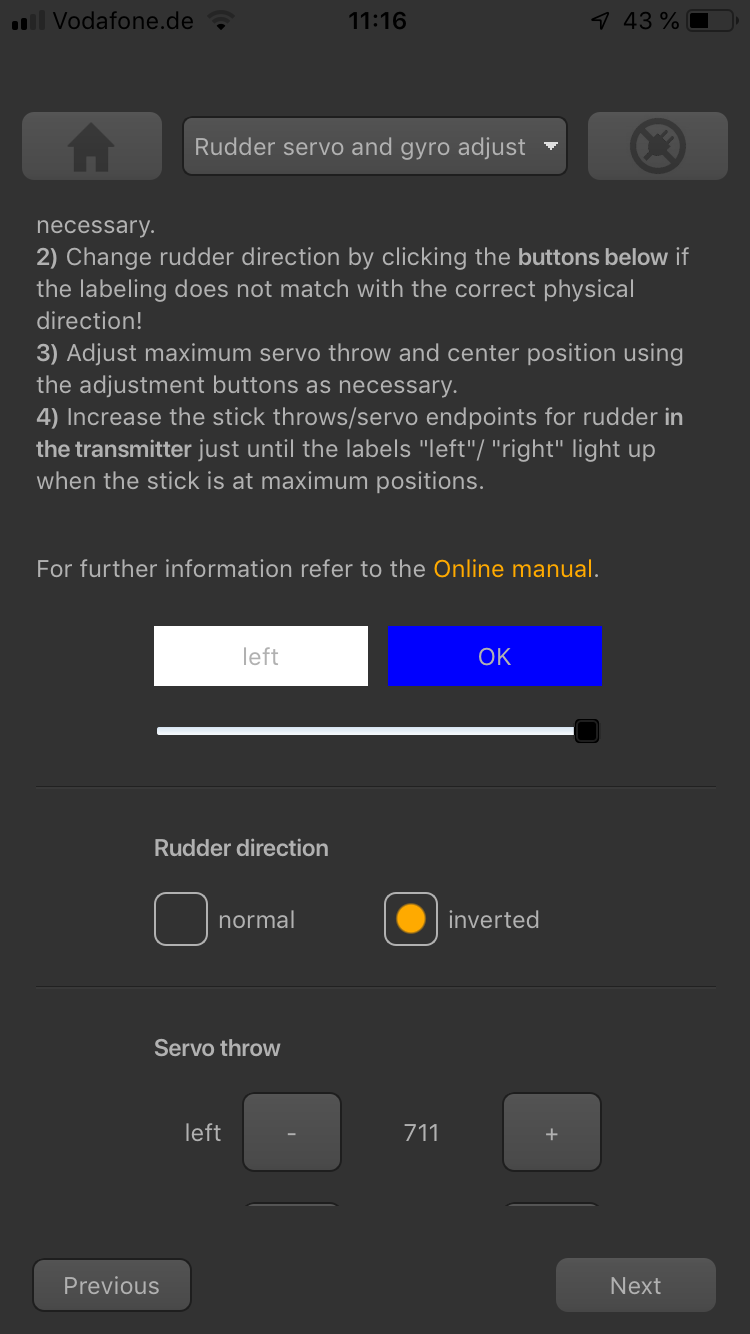
- Now check the rudder direction of the servo on the helicopter. If the stick is moving the servo into the wrong direction use the servo reverse function of your transmitter and reverse the rudder channel to set stick control direction correctly. When the servo is moving correctly, set the rudder direction of the BEASTX gyro: When you move the rudder stick/servo to the right, the Status LED must light up or flash in blue color. When you move the rudder stick to the left, the Status LED must light up or flash in red color. When the display is inverted (red = right and blue = left), reverse the display (internal control direction) by choosing either normal or inverted in the software.
<img class="ios" src="
<img class="ios" src="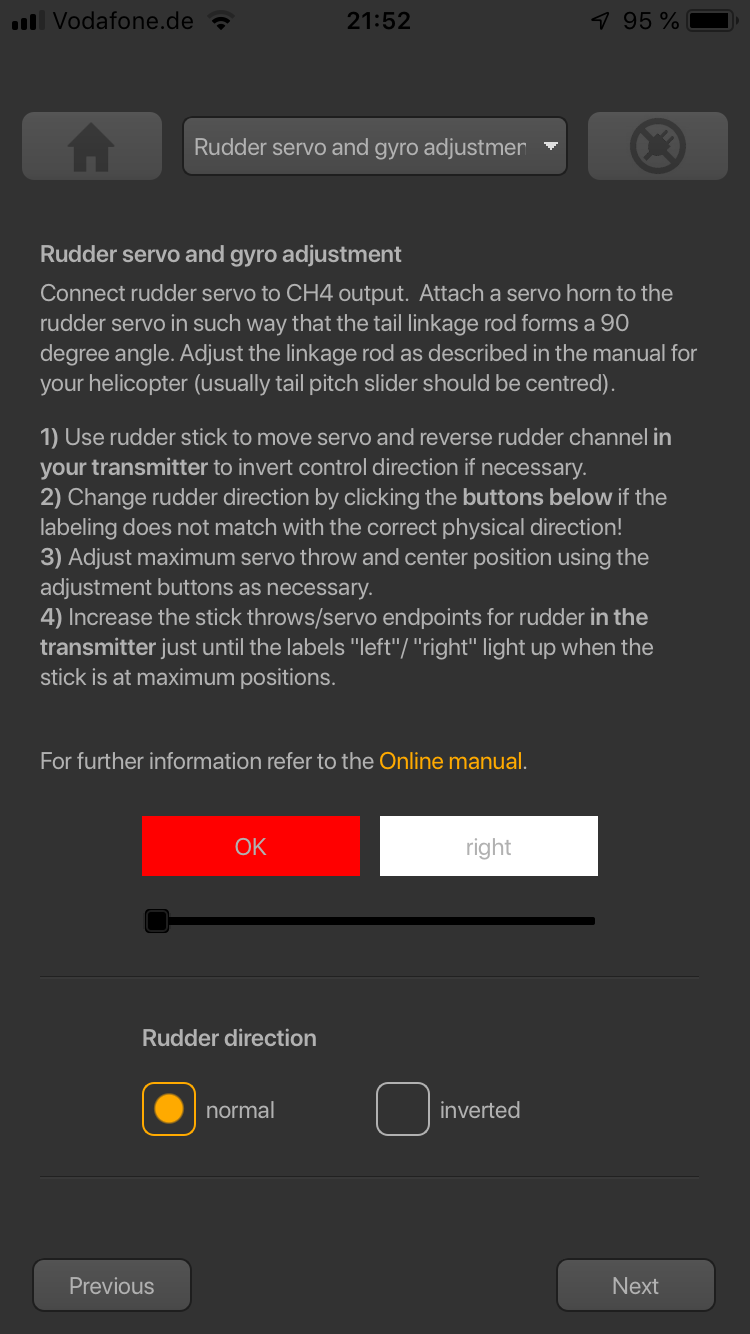
- Finally adjust the servo limit by changing the values in the two adjustment boxes for each direction. To do so, carefully use the rudder stick to move the servo to the endpoint (watch out to not jam the servo) and increase/decrease the endpoint as necessary.
<img class="ios" src="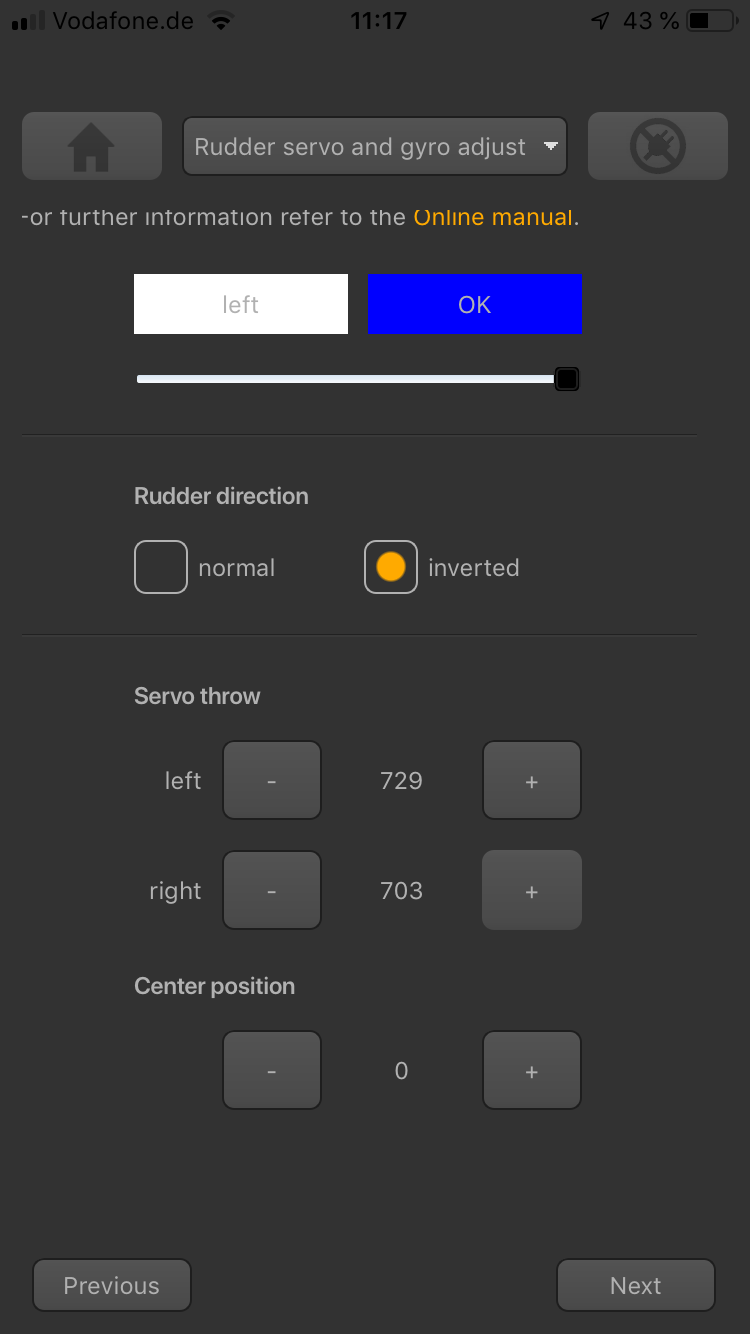
Always set servo directions in the transmitter first, then check the Status display of your BEASTX device or in the StudioX app. Change the internal control direction if it does not match the real direction. Do not change the internal direction in order to change the servo direction! This is only used for telling the gyro in which direction it must move the servo. Be very conscientious when doing this setup step, as wrong gyro direction will cause loss of control during takeoff and you probably crash the helicopter!
In addition you can check the gyro direction by turning the helicopter by hand around its vertical axis. When turning the heli the gyro must move the servo so that the rotor will produce a counter action agains the turn direction. So later in flight the gyro will stop the helicopter from unwanted movement.
Extra info: Why setting stick endpoints?
This ensures that control range of the radio system matches the internal range of the BEASTX system. Later when setting the control style you can adjust how fast your helicopter should turn around the vertical axis. To get reproducable results you have to match your radio to the system!
Extra info: How the gyro works!
The gyro always tries to steer in the opposite direction of the rotation that is applied to the helicopter. If you move the helicopter by hand around its vertical axis, the gyro must actuate a rudder servo movement to compensate this rotation. If for example you move the nose of the helicopter to the left (tail moving to the right), the gyro has to steer right the same way as you would steer right with the rudder stick, so that the tail is pushed back to the left.}}
-
When moving the tail to the right by hand (nose of the heli to the left), the gyro will steer to the right, so the tail is pushed back to the left.
-
When moving the tail to the right by hand (nose of the heli to the left), the gyro steers to the left and so the tail will move even further!
Please note: This only shows an example for the ALIGN T-Rex 500 helicopter. Actually the tail pitch slider may move to a different position on your helicopter. This mainly depends on how the tail blade grips are controlled and how the tail mechanics is constructed in general. Check the manual of your helicopter to find out which directions the rudder must move on your helicopter.
